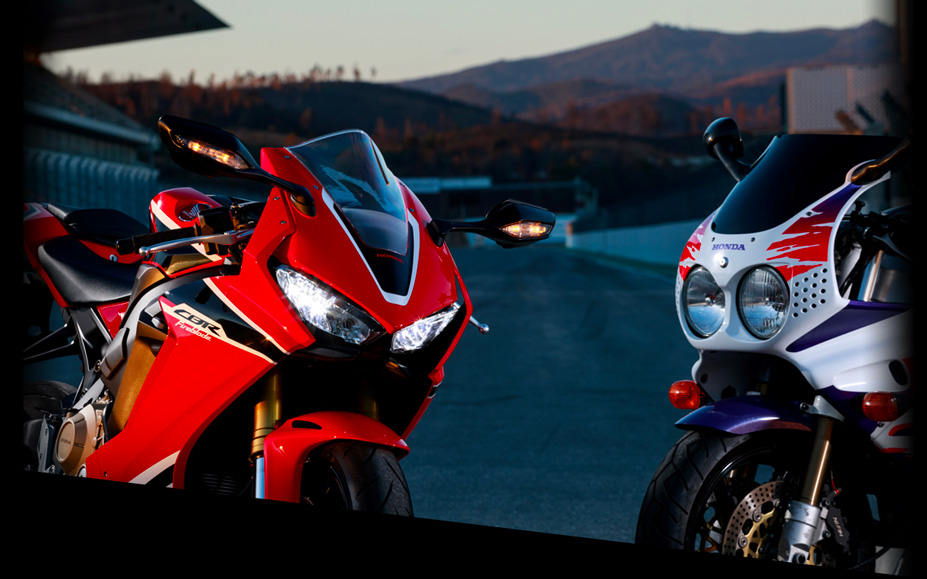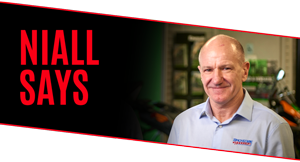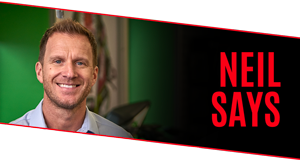
0333 0053 100

0333 0053 100


“Choosing my favourite Honda was always going to be a difficult task as I’ve got at least 10 that instantly spring to mind. As a teenager, I fantasised about owning any of the four-cylinder models that were arriving from Japan
at the time. To this day I still love the CB750 and CB500 or the super cute CB400 four.
"I own the technical marvel that is the NR750 and I’ve had the privilege of racing full factory NSR500s in Grands Prix for two full seasons. Their CRF
motocrossers are awesome and I’m currently searching for the lovely but rare FTR 230 Flat Tracker that I once trained on in California. Amazing bikes I’m sure you’ll agree, but I’ve narrowed things down to two machines
at opposite ends of the spectrum when it comes to price and performance.
“The humble C90 is really special for me as it was the first bike I owned that didn’t need pedal power. This was my introduction to biking, and I became hooked from that moment on. Forty Scottish pounds bought me freedom, fun and a ridiculously reliable motorcycle that would never let me down. And the fact that over 100 million Honda Cubs have now been sold since 1958 speaks for itself.
In the summer of 1975, I rode this step-thru bike three up, scrambled round fields, did mini Evel
Knievel jumps and she never missed a beat. To celebrate this, 40 years on I restored an almost identical grey C70 featured in Classic Motorcycle Mechanics that now takes pride of place in my shed.
“My other choice is the very exotic, money can’t buy, full factory RVF750. I raced this bike twice in the Suzuka Eight Hour event, widely regarded as the most important race of the year for the Japanese manufacturers. Victory in this race can have a big effect on the following year’s sales so Honda spares no expense.
"This V4 four stroke that spawned the RC30 was a masterpiece to look at and to ride. I’d travel to Japan at least twice to test before the event, helicoptered in and out after landing in Tokyo. The bike was a joy to ride as it had pin-sharp handling, smooth but strong power and was bang on the FIM weight limit.
"Honda owns the Suzuka Circuit so Japanese test riders spent many days perfecting this bike specifically for the ‘figure of eight’ Suzuka circuit. Although I qualified second on both occasions and led the race, unfortunately I failed to finish with a team mate crashing and the unthinkable, a Honda engine failure. The RVF 750, an absolute dream to ride and easily my favourite all-time race bike.”

“To me, Honda has always been the benchmark for all the manufacturers. Growing up, Honda always seemed to make the fastest and most reliable bikes. Nowadays it seems like everyone has caught up. Having said that, in the world of MotoGP, Marc Marquez and Honda have dominated over the past six seasons.
“I raced Hondas a few times in my career and won my first ever British championship on board a RS125 Honda in 1992 (I still have the bike). I then went on to race in the 125 world championships in 1993 and 1994. I loved my little RS Honda, they did everything you wanted them to do. Unfortunately, back then you didn’t have much power, only around 40bhp, so you had to ride the wheels off them which was a lot of fun.
“The next time I rode for Honda was in 2008 and 2009. I was racing in America at the time and it was an absolute honour to ride for the official America Honda team. Their workshops were very impressive as on one side you had the road race team and the other was the Motocross/Supercross team. I can’t lie, I spent most of my time on the off-road side ogling the trick factory parts and was always trying to blag stuff for my motocross bike. They were great times!”
Honda are one of the most recognisable bike manufacturers in the world with a huge range of bikes to choose from. And whether you have the Honda CBR125, CBR1000RR or the legendary Goldwing, Mackenzie Hodgson is able to provide the Honda bike insurance you need to get your pride and joy on the road.
Mackenzie Hodgson are able to provide a full range of insurance for your Honda bike, so whether you apply online with our simple and quick application form or on the phone to one of our UK based call centre experts you will get the cover you need
to get your Honda on the road.
Both of us have ridden bikes all our lives and now we are looking to ensure that riders, just like us, get the suitable insurance for their Bikes. We understand motorcyclists better than anyone and now we can help with their insurance.
Soichiro Honda’s fledgling motorcycle business, based in a wooden shed in Hamamatsu, had a rather grand name: the Honda Technical Research Institute. But the debut machine that he built in 1947 was contrastingly down-to-earth. The Model A held
a 50cc two-stroke engine in a bicycle frame with no suspension. Its single horsepower gave a top speed of about 20mph, and its smoky exhaust led to that first Honda being nicknamed the Chimney.
Simple as the Model A was, in some ways it was typical of the sophisticated bikes that would follow. It might have been smoky, due to the turpentine-based fuel common in Japan after the end of World War II. More importantly, the Model A was well-engineered,
reliable and competitively priced.
Honda-san was then aged 41, and already an experienced engineer and businessman, having built up a successful company manufacturing propellers and piston rings before selling it for a substantial sum. In 1949, he and his 20 employees produced their first complete bike: the 98cc two-stroke Model D, or “Dream”. Sales were good, progress was rapid and by 1953 the firm had developed the more sophisticated Model J Benly, whose 90cc four-stroke single-cylinder engine design was inspired by Germany’s NSU.
The first Honda to make an impact in export markets was the 250cc CB72 of the early 1960s. The sporty 250cc parallel twin made a useful 24bhp, and was held in a tubular steel frame. With a top speed of 90mph and good handling, the CB72 was a match for many larger British bikes. It was also reliable and oil tight, and did much for Honda’s growing reputation, which was further boosted by Mike Hailwood’s 250cc world championship win in 1961.
Honda’s spectacular racing success in the smaller classes was important for the growing firm, but even more vital was the success of the humble C100 Super Cub that was launched in 1958. Combining scooter-style full enclosure with large wheels and an engine placed in the conventional motorbike position instead of under the seat, the Super Cub offered convenience, economy, reliability, cleanliness and even style. Boosted by the famous advertising line “You meet the nicest people on a Honda”, it became the best-selling motorcycle of all time. Honda began its attack on the big-bike market in 1965, with the CB450 parallel twin, which sold slowly. But that certainly wasn’t true of the CB750 with which Honda stunned the motorcycle world in 1969.
The sophisticated CB750 was the first mass-produced four-cylinder bike, a fact emphasised by its impressive array of chromed tailpipes, and it incorporated an electric starter, disc front brake and five-speed gearbox. Regarded as the world’s first superbike, it led to smaller fours including the CB500 and CB400F and remains hugely influential today.
The GL1000 Gold Wing was the world’s biggest and heaviest bike when introduced in 1975. Unfaired, and most notable for its liquid-cooled flat-four engine, the GL also featured shaft drive, twin front disc brakes and an under-seat fuel tank.
The Wing’s smoothness and comfort won a large following, especially after Honda had introduced faired and kitted-out models including the Interstate and Aspencade. The Gold Wing’s size and sophistication reached new levels in 1988
with the introduction of the GL1500, powered by an all-new flat-six engine producing 100bhp. Three decades on, the latest Wing has an 1833cc flat-six and is more comfortable and better equipped than ever.
The six-cylinder CBX1000 was released in 1978 to demonstrate Honda’s ability to build powerful and technically advanced streetbikes, inspired by the firm’s brilliant multi-cylinder racers of the Sixties. The 1047cc, 24-valve powerplant,
with six shiny exhaust downpipes jutting from its bank of angled-forward cylinders, was left uncovered by frame tubes for maximum visual effect. The marque’s engineering prowess was highlighted in a different way by the CB1100R, an exotic
1062cc straight-four produced in small numbers mainly to win long-distance endurance races. Dominant on track, it also made a superb roadgoing superbike.
Honda’s early-Eighties range included the outrageous CX500 Turbo, less of a practical transverse V-twin motorcycle than a corporate statement of engineering expertise. But the marque’s engine layout of choice was the V4. The 1983-model
VF750F was an unreliable embarrassment but happily for Honda, the VFR750F that followed three years later proved outstanding and very robust. That model in turn led to the iconic VFR750R, better known by its code-name RC30, which redefined the
limits of sports bike design in 1988. Essentially a roadgoing copy of the factory RVF racebike that had dominated Formula One and endurance racing, the RC30 produced 112bhp and was almost unbeatable on road or track.
At the highest level of competition, though, the bike to beat was generally the factory NSR500. Grand Prix success took a while; even Honda couldn’t make the oval-pistoned NR500 four-stroke competitive against rival factories’ two-strokes.
But after Freddie Spencer and the NS500 triple had shown the way in 1983, the NSR500 demonstrated the value of V4 horsepower. Spencer won its debut title in 1985 (part of a spectacular double involving the NSR250 V-twin), and Wayne Gardner and
Eddie Lawson also took the title before Mick Doohan began his five-in-a-row domination in 1994. By the time Valentino Rossi rode to his first 500cc crown in 2001, the NSR made roughly 200bhp and had won ten world championships in 18 years.
While the NSR was winning on track, Honda’s showroom star was usually the CBR600F, a quick yet practical and competitively priced four that sold in huge numbers. The outstanding model of the Nineties, though, was the CBR900RR FireBlade, whose
blend of 123bhp open-class engine and mid-capacity size and weight revolutionised superbike design on its launch in 1992 and has made it a modern classic today. Numerous updates later, the current ‘Blade produces 189bhp and combines its
traditional compact size and light weight with electronic sophistication.
Honda’s delay before finally updating the Fireblade with high-level electronics in 2017 contributed to the feeling that the world’s largest bike firm has lost some focus. But with models as diverse as the cleverly reborn Africa Twin, aggressively
stylish CB1000R, usefully practical NC750 family, and cute Monkey and MSX125, there’s something in Honda’s range for just about every rider. And with Marc Márquez dominating MotoGP on the factory RC213V, there’s not much
doubt that Soichiro Honda’s business remains in good hands.